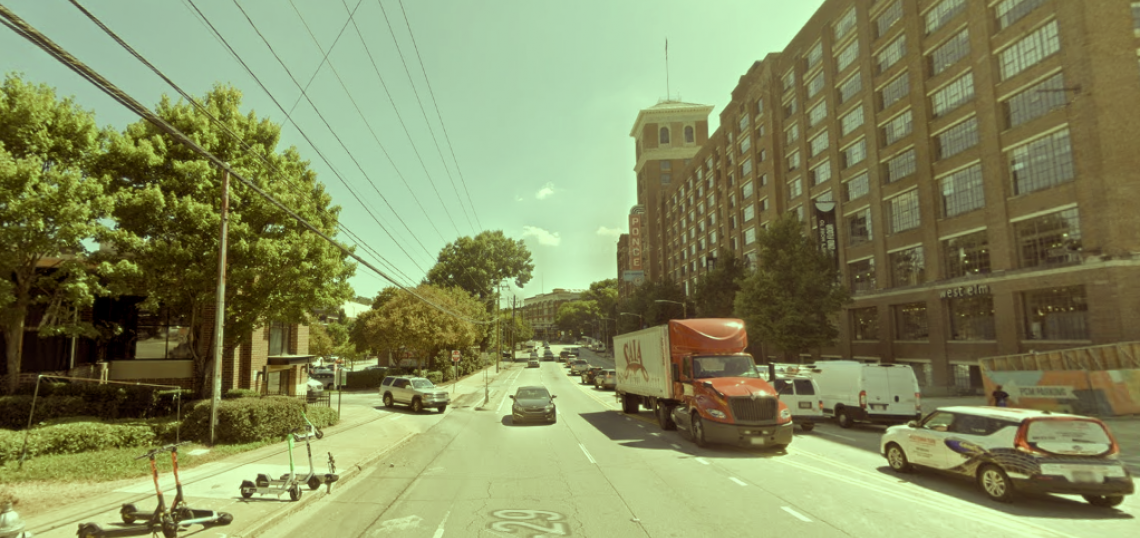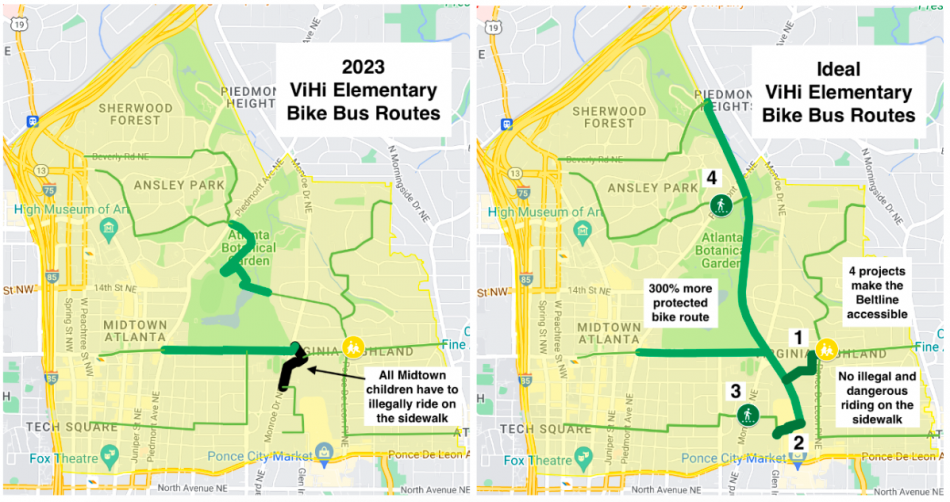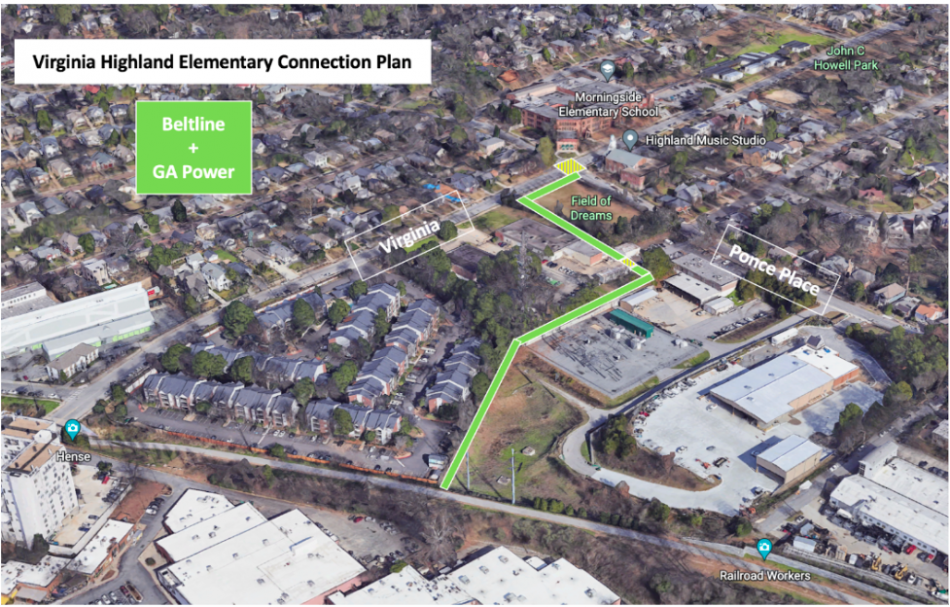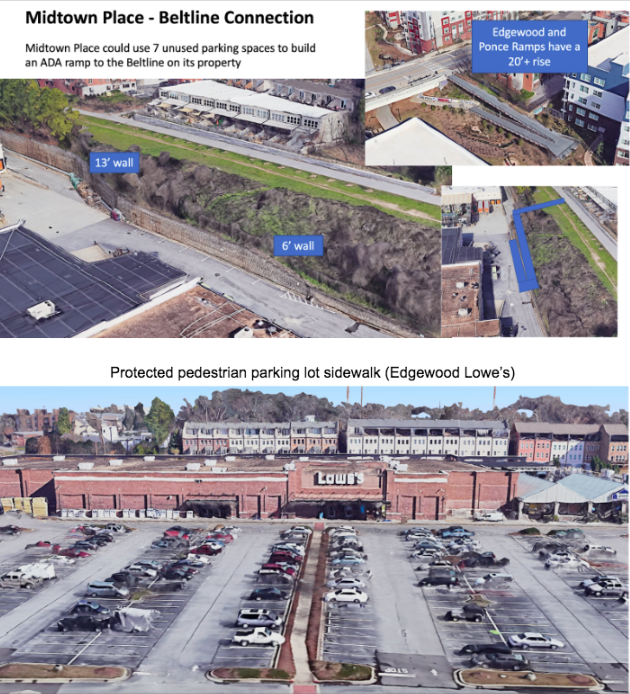Editor's note: Hugh Malkin, an Atlanta-based tech entrepreneur, was recently inspired by neighborhood controversy regarding a proposed pedestrian access point to Midtown Place, the notoriously chaotic shopping center where Whole Foods and Home Depot do business.
Some neighbors applauded the increased access, while others "organized, shouting fear of increased cars and crime," as Malkin puts it.
In any case, it got Malkin thinking bigger about non-vehicle access—and lack thereof—in one of the densest, most rapidly growing areas of Atlanta. And specifically how school-age kids are impacted today. Below, he summarizes the issue and points to specific projects he feels would make Midtown (and beyond) safer and more accommodating for kids on bikes and everyone else.
...
BIKING to school is essential for creating strong, healthy, independent children. The best biking routes to school minimize or remove our children’s exposure to cars, making the BeltLine the best path to school for many neighborhoods around Atlanta.
Unfortunately, most of Virginia-Highland Elementary’s 5 to 11-year-olds and the new school do not have safe access to the BeltLine. That’s despite the BeltLine passing less than a block from the facility.
Having the safest biking infrastructure in the world is useless if our most vulnerable cannot access it.
Without access to the BeltLine, all Midtown’s children are forced to illegally ride on the sidewalk along Monroe Drive, Kanuga Street, and Virginia Avenue because they have no protection from high-speed rush-hour traffic. Sidewalk riding is illegal, because it places the rider at the greatest risk due to cars crossing the sidewalk path and sidewalk disrepair, for which Atlanta is notorious.
Consider this: If a bicycle rider is hit on the sidewalk, the rider is at fault and could face fines up to $1,000 and jail time up to six months.
The four projects listed below are essential to separate our children from the danger of cars and keep them from being forced to ride on Atlanta’s sidewalks. These four projects have been on master plans for decades, but now is time to act because this new school serves Atlanta’s densest neighborhoods, and APS does not provide bus service within a mile of the school.
The City of Atlanta must prioritize these four projects today, as not doing so has already proven to be deadly for our older children, and it can get worse for our youngest.
Ideal bike and bus routes
Cars are the most dangerous obstacles our children face biking to and from school.
So all bike routes should aim to get kids to the carless BeltLine as quickly as possible. Atlanta can facilitate our children’s access to the BeltLine by prioritizing of the following four projects:
- Virginia-Highland Elementary School BeltLine Access (NO ETA)
- Midtown Place BeltLine Access (NO ETA)
- Pedestrian Crossing - Monroe at Greenwood (ETA January 2027)
- Pedestrian Crossing - Piedmont at Westminster (NO ETA)
...
1. Virginia-Highland Elementary School BeltLine access
There are two options to connect the new elementary school to the BeltLine.
The best option is also known as the “8th Street extension Multiuse Trail,” as show in the Atlanta BeltLine Subarea 6 Master Plan 2011. This trail borders the side of a Georgia Power-owned field to the APS-owned Field of Dreams. This trail would continue to separate children from cars from the BeltLine all the way to the new school. Ideally, this trail would include a bike ramp down from the BeltLine that can fit a cargo bike as well as an improved Virginia/Ponce Place intersection with raised pedestrian crossings.
The second option connects farther south on the BeltLine at Pylant Street. This would put kids on a slow residential street with cars to Ponce Place, which would still be better than biking on the sidewalk and crossing Virginia Avenue during rush hour.
The Subarea 6 Master Plan is currently being updated with a draft to be presented mid-to-late January. Now is the time to get the best option for our children prioritized and built as soon as possible.
2. Midtown Place BeltLine access
A connection through Midtown Place solves the problem of Midtown only having one access point to the BeltLine at 10th Street, or the soon-to-be-built Ponce connection.
Despite being a massive step in the right direction, the new Ponce streetscape has been limited so much by the Georgia Department of Transportation it is not an option for our children. It would force Midtown’s 5 to 11-year-olds to cross four lanes of traffic during rush hour as well as navigate multiple slip lanes from Midtown Place and then cross multiple drive-thru entries and exits.
The Midtown Place BeltLine cut-through is included in both the Atlanta BeltLine Subarea 6 Master Plan 2011 and the Midtown Garden District Master Plan 2017. Creating safe pedestrian and bicycle access will allow 5 to 15-year-old children south of 10th Street to safely access the BeltLine to go to Virginia-Highland Elementary as well as Howard Middle School.
This access is needed now and cannot wait for Midtown Place to be sold.
Midtown Place is unlikely to redevelop soon due to long-term tenant leases and their high profitability. Midtown Place’s tenants would greatly benefit from tapping into kids and their parents going to and from schools, as well as the 6,000+ pedestrians on the BeltLine behind their stores every day. The Midtown Neighborhood Association has already begun to work with Coro Realty (Midtown Place’s owner) to increase access, but this new school has created a pressing need to expedite this access.
Ideally this crossing will include a protected sidewalk through the parking lot, raised crossings at the two traffic points at the front and back of the parking lot, and a wide enough ramp for a cargo bike to travel up to the BeltLine from the back of the parking lot (similar to the Edgewood Avenue ramp).
There is plenty of room for all of this on Coro’s property, as seen in the images below.
3. Pedestrian Crossing - Monroe at Greenwood
This intersection is at a unique place on Monroe Drive where the three-lane road switches from two lanes in one direction to two lanes in the other.
This switch and the extra-wide lanes make any crossing pedestrian extremely vulnerable to being stuck by a confused speeding car.
Creating a safe pedestrian Monroe Drive crossing at Greenwood will allow 5 to 15-year-old students south of 10th Street to safely access the BeltLine—and by extension, Virginia-Highland Elementary and Howard Middle School. This crossing has been designed as part of the Monroe Complete Street project, but it’s not expected to be complete until January 2027. When today’s freshman will be in college, in other words.
APS’s current plan is to spend money to extend bus routes to a few of the students affected by the dangers of crossing Monroe Drive. The year 2027 is far too long to wait for this crossing for both the students who could easily walk or bike to school and APS’s bussing budget.
It’s included in Monroe Complete Street South of 10th, Atlanta BeltLine Subarea 6 Master Plan 2011, and Midtown Garden District Master Plan 2017—but is somehow still in design. Ideally this crossing will include a real-time stop signal, raised crossing to the sidewalk level, and a pedestrian island.
4. Pedestrian Crossing - Piedmont at Westminster
Creating a safe pedestrian crossing over Piedmont Avenue at Westminster Drive, near Atlanta Botanical Garden, will allow 5 to 18-year-old students south of Beverly Road to safely access the BeltLine en route to Virginia-Highland Elementary, Howard Middle, and Midtown High schools.
This crossing should be included in the currently in-design Piedmont Complete Street Project, Atlanta Botanical Garden Expansion and the Atlanta Beltline Subarea 6 Master Plan 2011.
Ideally this crossing will include a real-time stop signal, raised crossing to the sidewalk level, and a pedestrian island if the new Piedmont Avenue streetscape is wider than two lanes of traffic.
How you can help
Again, having the safest biking infrastructure in the world is useless if our most vulnerable cannot access it.
Prioritizing these four projects will have a massive impact on hundreds of children going to and from school, as well as all Atlantans trying to bike rather than clog our roads. This prioritization will have an immediate impact on the strength, health, and independence of Atlanta’s future. So please … Click here to help change this!
• Recent alternate transportation news (Urbanize Atlanta)












